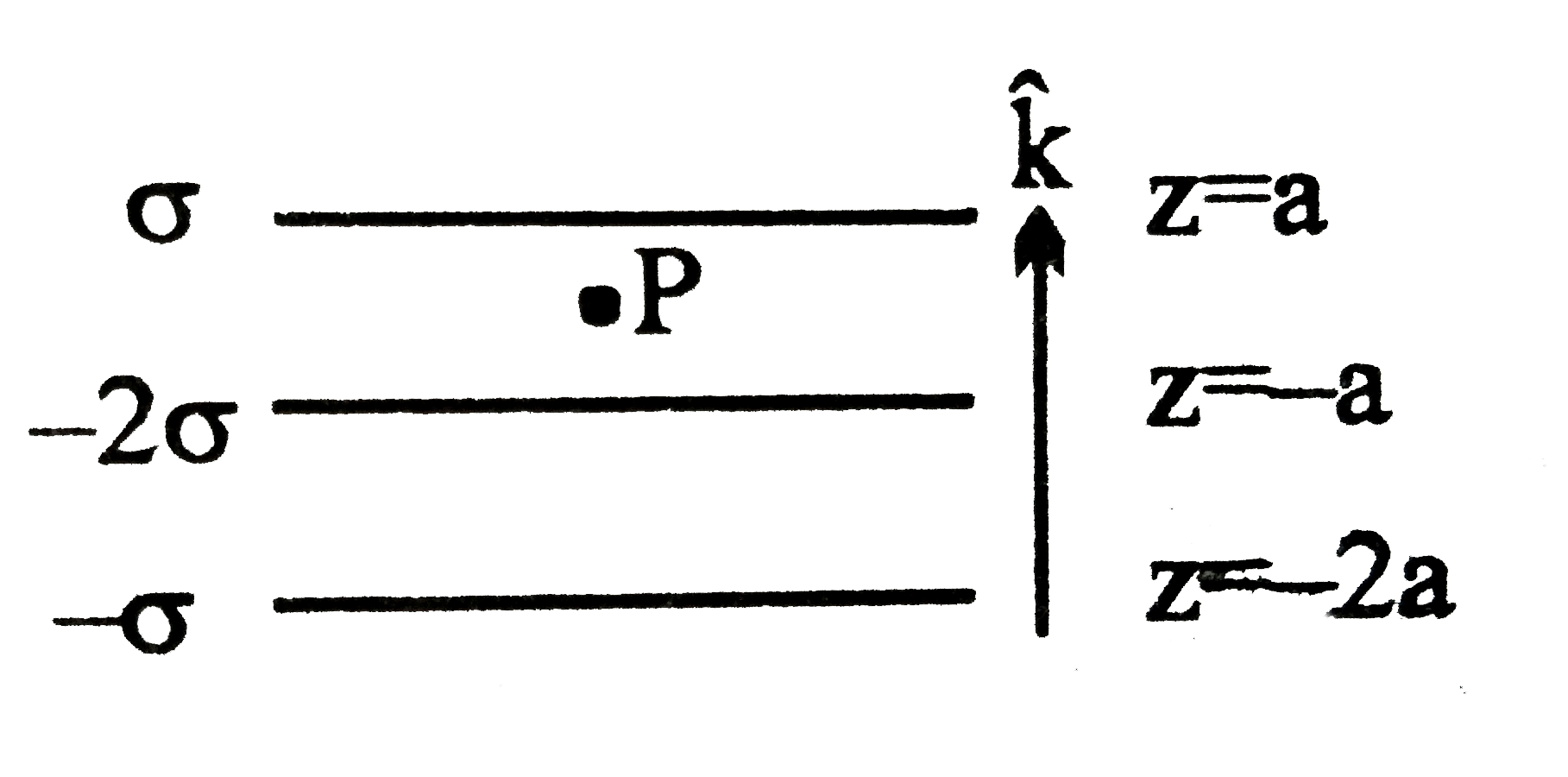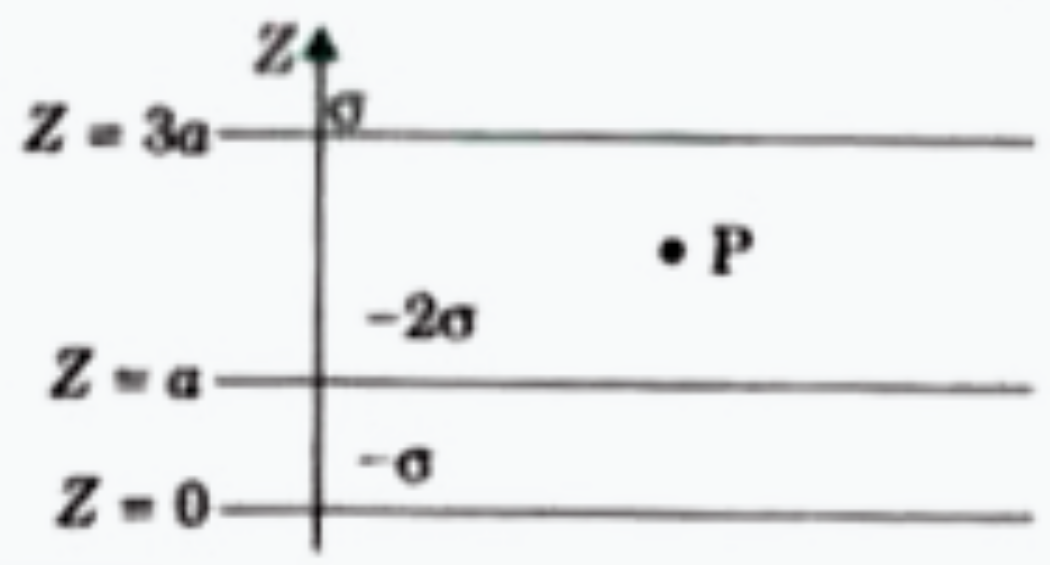A charge Q is uniformly distributed over a large plastic plate. The electric field at a point P close to the centre of the plate is 10Vm−1. If the plastic plate is replaced by a copper plate of the same geometrical dimension and carryin the same charge Q1 the electric field at the point P will become
zero
5Vm−1
10Vm−1
20Vm−1.
The correct Answer is:C
To solve the problem, we need to analyze the electric field produced by a uniformly charged plate and how it behaves when the plate material is changed from plastic to copper.
1. Understanding the Electric Field from a Charged Plate:
The electric field (E) produced by an infinite plane sheet of charge with surface charge density (σ) is given by the formula:
E=σ2ϵ0
where ϵ0 is the permittivity of free space.
2. Given Information:
- The electric field at point P near the center of the plastic plate is E=10V/m.
- The charge Q is uniformly distributed over the plate.
3. Surface Charge Density:
Since the electric field due to the plastic plate is known, we can express the surface charge density σ as:
σ=2ϵ0E
Substituting the given electric field:
σ=2ϵ0×10V/m
4. Replacing the Plastic Plate with Copper:
When the plastic plate is replaced with a copper plate, the charge Q remains the same, and the geometrical dimensions of the plate are unchanged.
5. Electric Field from a Conducting Plate:
For a conducting plate, the electric field outside the conductor is also given by the same formula:
E=σ2ϵ0
The key point is that the electric field produced by a uniformly charged conductor (like copper) is the same as that produced by a uniformly charged non-conducting plate (like plastic) when the charge distribution is the same.
6. Conclusion:
Since the charge Q and the dimensions remain the same, the electric field at point P will also remain the same:
E=10V/m
Final Answer:
The electric field at point P when the plastic plate is replaced by a copper plate will still be 10V/m.
---
The electric field (E) produced by an infinite plane sheet of charge with surface charge density (σ) is given by the formula:
E=σ2ϵ0
where ϵ0 is the permittivity of free space.
- The electric field at point P near the center of the plastic plate is E=10V/m.
- The charge Q is uniformly distributed over the plate.
Since the electric field due to the plastic plate is known, we can express the surface charge density σ as:
σ=2ϵ0E
Substituting the given electric field:
σ=2ϵ0×10V/m
When the plastic plate is replaced with a copper plate, the charge Q remains the same, and the geometrical dimensions of the plate are unchanged.
For a conducting plate, the electric field outside the conductor is also given by the same formula:
E=σ2ϵ0
The key point is that the electric field produced by a uniformly charged conductor (like copper) is the same as that produced by a uniformly charged non-conducting plate (like plastic) when the charge distribution is the same.
Since the charge Q and the dimensions remain the same, the electric field at point P will also remain the same:
E=10V/m
The electric field at point P when the plastic plate is replaced by a copper plate will still be 10V/m.
Topper's Solved these Questions
- GAUSS LAWBOOK - HC VERMACHAPTER - GAUSS LAWEXERCISE - Objective 2
8 Videos
- GAUSS LAWBOOK - HC VERMACHAPTER - GAUSS LAWEXERCISE - Exercises
24 Videos
- GAUSS LAWBOOK - HC VERMACHAPTER - GAUSS LAWEXERCISE - Short Answer
7 Videos
- ELECTROMAGNETIC WAVESBOOK - HC VERMACHAPTER - ELECTROMAGNETIC WAVESEXERCISE - Exercises
9 Videos
- GEOMETRICAL OPTICSBOOK - HC VERMACHAPTER - GEOMETRICAL OPTICSEXERCISE - Exercises
79 Videos
Similar Questions
Knowledge Check
A charge q is uniformly distributed over a large plastic plate. The electric field at a point P close to the centre and just above the surface of the plate is 50 V/m. If the plastic plate is replaced by a copper plate of the same geometrical dimensions and carrying the same uniform charge q, the electric field at the point P will become :
AzeroB25 V/mC50 V/mD100 V/mCharges q is uniformly distributed over a thin half ring of radius R. The electric field at the centre of the ring is
Aq2π2ε0R2Bq4π2ε0R2Cq4πε0R2Dq2πε0R2A charge Q is uniformly distributed over one large insulating surface and field intensity at a point X near its centre E. If it were a metal plate in place of an insulating surface then the electric field intensity at point X will become
AEBE/2C2ED4E
Two large conducting plates X and Y. each having large surface area A (on one side), are placed parallel to each other as shown in figure (30-E7). The plate X ia given a charge Q whereas the other is neutral. Find (a) the surface charge dendity at the inner surface of the plates X, (b) the electric field at a point to the left of the plates, (c) the electric field at a point in between the plates and (d) the electric field at a point to the right of the plates.

View SolutionElectric field intensity at point P due to charge distributed over a sphere is:

View SolutionThree large parallel plates have unifrom surface charge densities as shown in the figure. What is the electric field at P
 .
.
View SolutionA parallel plate capacitor has an electric field of 105V/m between the plates. If the charge on the capacitor plate is 1μC, the force on each capacitor plate is
View SolutionThe electrical field in the gap of a condenser charges as 1012Vm−1s−1. If the radius of each plate of the condenser is 3cm, the magnetic field at the edge of plate in the gap is
View Solution


